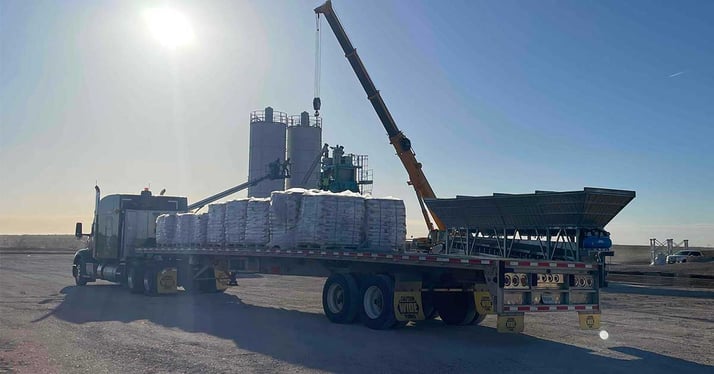
- How the dry van and reefer markets shift in June
- How open-deck capacity changes in June
- How national events impact capacity in June 2025
June is a jam-packed month in the transportation industry. In fact, it’s one of our busiest times of year.
From the first wave of summer produce season in Georgia to the transport of farming equipment and construction machinery around the nation, you'd be hard-pressed to find an unused trailer throughout June. (In fact, many are overbooked!)
To give you an idea of how busy things are, here at Anderson Trucking Service (ATS), we typically see about a 15 percent uptick in freight volumes in June compared to May.
What’s the cause of all this activity? The demand increase that comes with the end of frost law restrictions and the start of construction and produce seasons, for starters.
June is also bookended by national holidays that send drivers home to their readily awaiting family and friends — crunching capacity in the process. And this June in particular may be especially busy as shippers anticipate possible changes to U.S. tariff policies.
In this article, we’ll break down what to expect in June 2025 in the transportation industry. The more you know about what to expect this month, the better prepared you’ll be to succeed!
Dry Van and Reefer Capacity In June
When it comes to your ability to find dry van and reefer capacity throughout June, there are two main factors you’ll want to keep in mind:
These seasonal shifts play a significant role in tightening dry van and reefer capacities across our nation in June. Let’s talk about it:
Produce Harvest in the Southern United States
June marks the initial wave of produce harvest and distribution throughout the southern U.S., particularly in coastal states. As farmers conduct their harvests, they’ll need truck space to transport their products to the shelves of grocery stores across the country.
This influx of demand makes the South an absolute hotbed for dry van and reefer activity in June, which means finding a truck to go out of these areas will cost more.
The transportation of high-liability, perishable freight fetches truckers a pretty penny, so carriers are highly motivated to keep their trucks concentrated in these areas.

On the other hand, if you’re a shipper looking to move reefer or dry van freight into these areas, capacity will be easy to find.
If your freight will help drivers access the high demand in these regions without running empty miles, you can all but name your price — you’ll find plenty of takers.
Household Goods Season Nationwide
“Moving season” officially spans from May to September annually, but in the transportation industry, we mark its arrival in June, when the movement of household goods across the U.S. ramps up significantly.
Why June? It’s the end of the school year and the beginning of summer, making it the perfect time for families (and all their furniture, clothes, kitchenware, etc.) to move.
The moving companies these folks engage will need to find dry van capacity to help them hold up their end of the bargain. In turn, dry van demand capacity tightens.
While you may well find a dry van available this month, you’re unlikely to find it at the same price point as in, say, April. Expect to pay more to secure the enclosed capacity you need.
Open-Deck Capacity in June
Good weather and the promise of a long, productive summer sparks higher demand for open-deck capacity nationwide starting in June.
In the northern U.S., the snow has melted, the grass is green, and the sun is hot, which means frost laws — which dictate gross weight limits on interstate highways in this region — no longer apply.
As such, the large, heavy construction equipment that couldn’t be transported in colder months can finally move on interstate roadways in June.

Expect larger freight like farm equipment, construction equipment, and other oversized machinery to soak up a large portion of open-deck capacity as the seasons change in northern and Midwest regions.
If you’re shipping in or around these areas, open-deck capacity is going to be harder to find, and therefore more expensive. Expect to pay a bit more as demand rises like those balmy summer temps.
The southern U.S. also becomes a hotbed for open-deck freight in June. This can be attributed to the start of produce (Yep, some produce can travel on a flatbed!) and construction seasons in the South during this time.
For shippers, this may feel like deja vu; just like dry van and reefer capacity headed into the South, open-deck capacity will be cheaper going into the South than out.
How National Events Impact Capacity in June 2025
Unlike any other month, June is sandwiched between two national holidays and marks the end of a fiscal quarter. And, unfortunately for shippers, each of these events impact capacity in distinct (but equally disruptive) ways.
On top of these annual disruptions, June 2025 is uniquely positioned as it relates to anticipated changes to the U.S.'s tariff policies, which may also drive changes to capacity.
Let’s dive deeper into these nationwide events and their effect on truck capacity this month.
National Holidays and Truck Capacity
On the calendar, June sits snugly between Memorial Day weekend and the Fourth of July. These two national holidays mark a time of leisure for many Americans, including the hard-working truck drivers who keep our economy moving — literally.
Truck drivers generally try to spend these holiday breaks at home with their family and friends, which means there will likely be fewer drivers available to haul freight during that time.
While the country kicks up their feet over national holidays, the demand for trucking services doesn’t stop. That means post-Memorial Day demand (including those shipments rescheduled to avoid shipping over the long weekend) will spill into June.
Combine that with the tendency for shippers to avoid the congestion of the Fourth of July weekend by shipping more in June, and you’ve got a perfect recipe for increased freight rates as demand shifts.
Expect to pay more to move freight in general in June, but especially the weeks of June 2 and June 30. If you can schedule your shipments to strategically avoid these periods, do so — your budget will thank you.
The End of Quarter Two (Q2) and Truck Capacity
The end of Q2 — and the end of June — marks the halfway point of the calendar year.
Quarterly and bi-annual reporting will be completed at the conclusion of Q2. This makes businesses highly motivated to increase inventory distribution and wrap up any major projects before that time.
As such, companies tend to increase their demand for capacity as the end of the month grows nearer. This tightens capacity nationwide, leading to higher rates for shippers.

While this market shift is inevitable, it’s also predictable — which means you can prepare for it. Try to schedule your most critical shipments in the first two weeks of June, if possible.
This will help you avoid the capacity crunch caused by last-minute inventory pushes in the final half of the month.
Tariffs and Truck Capacity
As of this article’s publication, the 90-day pause on reciprocal tariffs announced April 2 affecting over 100 countries is set to expire on July 9, 2025.
That means countries that have not negotiated a deal with the Trump administration to lower their rate will see the previously announced tariff rates take effect.
In anticipation of tariffs resuming in early July, shippers — particularly importers/exporters and those shipping project freight with an international footprint — may rev up their freight volumes throughout June.
This demand for truck capacity (all that freight needs to get from the ports to storage and distribution somehow!) would compound with the additional market strains already at play in June, likely leading to higher rates.
While we can’t know for certain what the impact of the July 9 pause expiration will be as it relates to the transportation industry, rest assured we’ll be watching the tariff situation closely in the coming weeks — and we recommend you do, too.
RELATED: 5 Signs It's Time to Upgrade Your Import/Export Cargo Strategy
Plan Smarter All Year Long
Now that you know what to expect from the transportation industry in June 2025 — from tightening dry van, reefer, and open-deck capacity to the ripple effects of holidays, quarter-end pressures, and tariffs — you’re in a much better position to navigate it all with confidence.
Understanding these seasonal and market dynamics is half the battle. With these insights in hand, you can plan smarter, minimize costs, and keep your freight moving smoothly during one of the busiest months on the calendar.
And speaking of calendars: looking for even more ways to get ahead this year? Check out our 2025 Freight Shipping Calendar for a full view of the best and worst (read: most and least costly) days to ship this year. Your shipping strategy will thank you.


